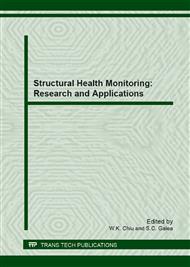[3]
where Fy is the magnetic force (N) acting on the ball bearing in the y direction given a y displacement (m), k1 is the linear spring constant (N/m), and k3 and k5 are the nonlinear spring constants (N/m3 and N/m5 respectively). The spring constants are fitted to data points determined by FEA modelling in COMSOL, as shown in Fig. 3(c). The oscillatory motion of the bearing can then be described using a modified form of the Duffing equation. Since the energy harvester is base driven (i.e. attached to an oscillating host-mass), the relative motion of the bearing with respect to the base is u(t) = y(t) ‾ s(t), where y is the absolute displacement (m) of the bearing and s is the displacement (m) of the host. The quintic Duffing equation can be expressed as
Google Scholar
[4]
where the host acceleration is written as , and where Ω is the host frequency and a is the amplitude of the host acceleration, M is the mass of the bearing, m is the total damping coefficient, and k1, k3, k5 are the previously defined spring constants. The primary resonant solutions of a forced quintic-modified Duffing oscillator are found using the homotopy analysis method (or HAM [[] S. Liao, Y. Tan, A General Approach to obtain Series Solutions of Nonlinear Differential Equations, Studies App. Math. 119 (2007) 297-354. ]), and for simplicity truncated to the harmonic response
DOI: 10.1111/j.1467-9590.2007.00387.x
Google Scholar
[5]
where A0 and b represent the nonlinear amplitude and drive-response phase difference, respectively. For details on the derivation and modelling applicability of the full HAM result and the Duffing equation for this harvester setup, refer to previous publications [19]. Of interest to the modelling of the mechanical dynamics for coil output characterization is the frequency displacement relation governed by the nonlinear frequency-amplitude relation
Google Scholar
[6]
The equivalent linear viscous damping m was experimentally determined to be in the range of 0.10 – 0.15, depending on coil height h (i.e. the ball bearings closeness to the magnet determines the magnetic normal (contact) force Fz, which influences the system damping). However, since small variations in the damping value only affects the value of the anomalous jump frequencies [[] D. W. Jordan, P. Smith, Nonlinear Ordinary Differential Equations, fourth ed., Oxford University Press, Oxford, 2011. ], the voltage development is not heavily reliant on the damping and an intermediate value of m = 0.125 Ns/m is used. Finally, by determining Fy for each coil height, the frequency-amplitude relation governing the mechanical dynamics for each experimental configuration can be developed. (iii) Modelling of the Induced Voltage The harvester model discussed in section (i) included a coil (the 'Multi-Turn Coil Domain') that allowed COMSOL to calculate the induced coil EMF due to ball bearing motion. In this section, the coil is removed from the model (replaced by an air domain of equal volume) and predictions of the induced coil EMF are made from a first-principles calculation based on the magnetic flux changes within the coil's volume. Given the assumptions of quasi-static behaviour, modelling the magnetic flux becomes a simple task for FEA-based techniques such as COMSOL. A three-dimensional model of similar geometry to Fig. 3(a) is constructed; however in this case the coil is modelled as an air gap instead of an active element. The Magnetic Fields No Currents (MFNC) interface is used to evaluate the B field (magnetic flux density) by enforcing flux conservation. A stationary solve is performed across varying parameters of coil height and ball bearing displacement in the y direction. As shown previously in Fig. 3(a), the change in magnetic flux in the coil region as the bearing is displaced induces a voltage in the coil. Reconsidering Eq. 2, the voltage induced by the coil is a function of the magnetic flux through each wire loop of the coil, where the flux in each wire loop is defined as the surface integral of the B field component normal to the surface enclosed by the loop, i.e. , and (7) , (8) where the Bz is the z direction component of the B field, and Si is the surface enclosed by the i-th coil wire loop (normal to the z direction). The coil loops are modelled as simple square packed array within given parameters of outer (rout) and inner radius (rin), and coil height (h). The packing fraction of such an arrangement is , compared to a more practical coil with hexagonal packing [[] H. Chang, L. Wang, A Simple Proof of Thue's Theorem on Circle Packing, arXiv (2010) 1009.4322. ]. Therefore, when comparing to a prototype coil, a coil turns ratio Nratio of is used. Given that coil loops are represented discretely, the surface integral of Eq. 8 is computed as, , (9) where Bz(x,y) is the discrete value of the Bz field at an interpolated point (x,y) on the surface Si, and dx and dy are sufficiently small widths of interpolation. Combining Eq. 7 and Eq. 9, and including the coil turns ratio, a final expression for determining the induced voltage in a coil as a function of time is developed, . (10) By coupling the COMSOL model described in this section to the dynamics derived in section (ii), Eq. 10 can be computed numerically for a given coil geometry (rwire, rout, rin, h) and various drive levels (a, Ω). Finally, power across a matched resistive load can be calculated as
Google Scholar


